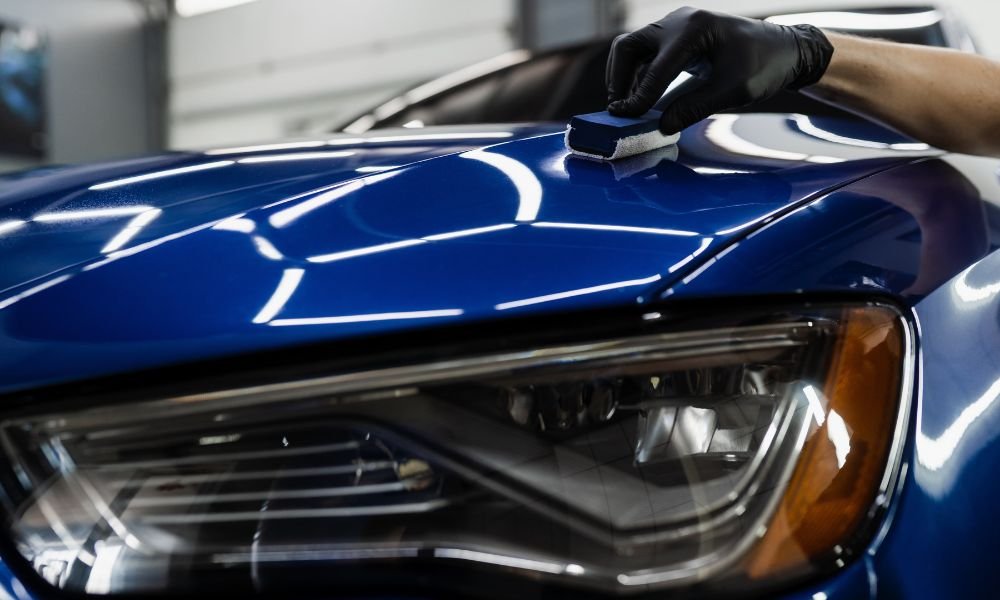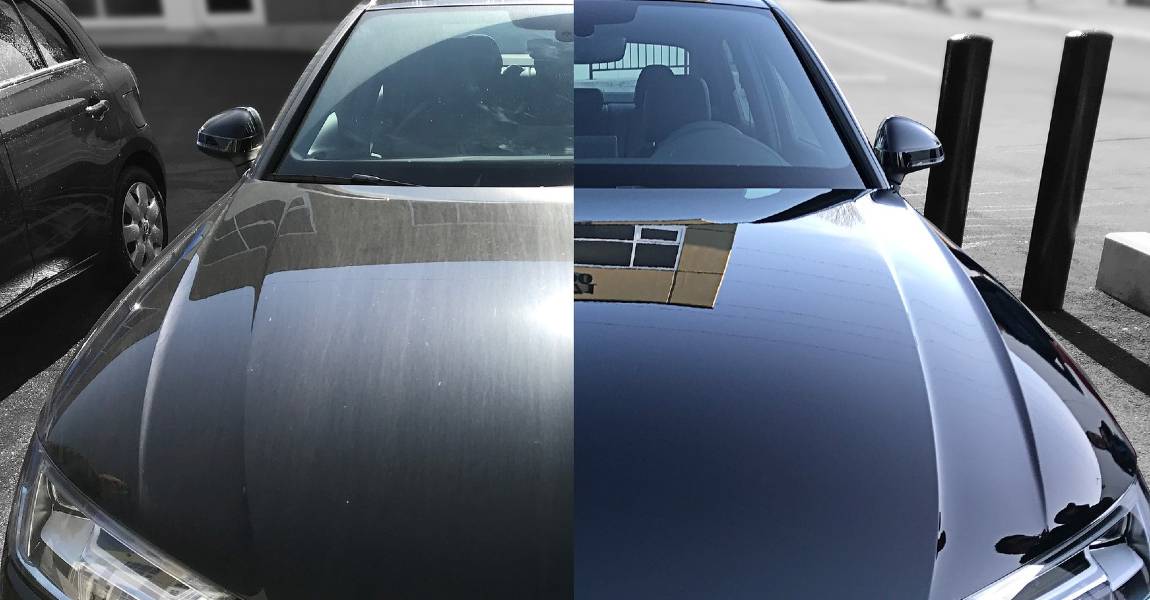Ceramic Coating vs. Standard Wax: Which One Provides Superior Defense?
Ceramic Coating vs. Standard Wax: Which One Provides Superior Defense?
Blog Article
Understanding the Scientific Research Behind Ceramic Coating for Enhanced Car Sturdiness
The scientific research of ceramic covering is transforming lorry maintenance by supplying an awesome shield versus harsh environmental elements. At its core, this innovation utilizes the power of silicon dioxide and titanium dioxide to form a durable, protective layer. What exactly makes these substances so reliable in safeguarding a car's outside? As we check out the intricate make-up and application process of ceramic finishings, we uncover the tricks behind their remarkable defense and long life. Exactly how does this contrast to traditional approaches, and what ramifications does it have for vehicle maintenance in the long term? The answers might shock you.

Composition of Ceramic Coatings
Ceramic finishes are largely made up of silicon dioxide (SiO2), which is originated from natural products like quartz and sand. This compound creates the backbone of the finishing, supplying its characteristic firmness and resistance to ecological aspects. In enhancement to SiO2, ceramic finishings often include titanium dioxide (TiO2) for enhanced UV defense and enhanced resistance to ecological pollutants. These nanocomposite materials produce a robust, chemical bond with the car's surface area, offering a long-lasting protective layer.
The formulation of ceramic coatings is a thorough process where the focus of SiO2 can substantially affect the finishing's performance. Higher SiO2 web content commonly leads to better sturdiness and hardness, contributing to the finish's capacity to stand up to scratches and chemical etching. Nonetheless, the balance of components is essential; as well much SiO2 can make the coating breakable, while too little can endanger its safety residential properties.
Suppliers may additionally integrate extra materials, such as polysilazane, to boost versatility and convenience of application. These ingredients improve the finish's hydrophobic residential properties, making certain water and contaminants bead off the surface easily. This crafted make-up highlights the efficiency of ceramic coverings in guarding an automobile's outside versus a selection of negative problems.
Application Refine Clarified
Applying a ceramic covering to a vehicle involves a number of critical actions, each important to making sure ideal bond and performance of the protective layer - ceramic coating. The procedure starts with a detailed wash and purification of the vehicle's surface area to get rid of dirt, crud, and previous waxes or sealers. This step is essential as any type of pollutants left externally can prevent the finish's capacity to bond successfully
Following the preliminary cleansing, the following action involves brightening the vehicle to remove any type of imperfections, such as swirl marks or scrapes. Sprucing up makes sure a smooth surface area, which is essential for the covering to stick correctly and offer an uniform finish. After brightening, a surface prep work spray is utilized to remove any type of remaining deposits and make certain that the surface area is completely tidy.

Protective Advantages
Typically hailed for its exceptional protective high qualities, a ceramic finishing offers many benefits that considerably enhance automobile longevity. At its core, ceramic layer develops a hard, semi-permanent barrier over an automobile's exterior, which works as a shield his explanation against numerous ecological threats. This advanced layer of security effectively defends against UV rays, oxidation, and fading, maintaining the car's original paint and luster. It reduces the risks positioned by damaging impurities such as bird droppings, tree sap, and road crud, which, if left without treatment, can cause long-term damage.
Additionally, ceramic coatings display hydrophobic residential properties, meaning they drive away water and facilitate a self-cleaning result. This characteristic reduces the adherence of dust and mud, streamlining upkeep and cleaning procedures. The covering's resistance to chemical etching better makes sure that the car's surface area stays unblemished in spite of direct exposure to extreme cleaner and contaminants.
In enhancement to these safety benefits, the ceramic layer boosts a vehicle's visual allure by producing a shiny coating that accentuates color deepness and clarity. This not only sustains the car's visual charm yet also adds to its long-lasting value by protecting the stability of its exterior with time.
Contrasting to Conventional Methods
Unlike conventional techniques of car protection, such as waxing or sealants, ceramic coverings offer an even more resilient and lasting service. Where waxes and sealers normally supply a temporary layer of security, frequently needing reapplication every couple of months, ceramic finishings develop a semi-permanent bond with the car's paint. This bond creates a safety layer that is immune to environmental impurities, UV damage, and minor abrasions.
Standard waxes are mainly composed of all-natural parts like carnauba wax, supplying a glossy coating yet lacking the durable safety high qualities of ceramic finishings. Sealants, while artificial and offering a little better resilience than waxes, still drop short in comparison to the resilience and chemical resistance of ceramic layers. The innovative technology of ceramic coverings incorporates nanotechnology, which allows them to complete tiny flaws in the paint surface, causing a smoother and a lot more hydrophobic surface.
In terms of application, ceramic layers need a more careful procedure, often necessitating professional setup to make certain optimum efficiency. This contrasts with the reasonably simple application of waxes and sealers, which can be used in your home. The exceptional defense and visual improvement given by ceramic coverings justify the investment for those looking for lasting automobile conservation.
Durability and Maintenance
How does the longevity of ceramic finishings equate into simplicity of upkeep for automobile proprietors? The innovative formulation of ceramic finishes gives a durable protective layer on the vehicle's surface area, which dramatically prolongs the life-span of the vehicle's exterior surface.
Additionally, the hydrophobic nature of ceramic finishings allows water and various other fluids to grain up and roll off the surface area, lugging dirt and debris with them. This property reduces the buildup of pollutants, making regular cleansing more effective and less labor-intensive. Owners take advantage of a continually smooth, glossy look with minimal initiative. While the layer itself is long-lasting, it is not completely maintenance-free. Regular Get the facts inspections for damages and periodic reapplication are advised to guarantee the protective layer remains intact. Hence, ceramic coatings supply a useful equilibrium in between lasting resilience and simplified upkeep for vehicle care.
Verdict
Ceramic finishings, with their sophisticated chemical structure of silicon dioxide and titanium dioxide, give a powerful obstacle against ecological damages, considerably boosting vehicle durability. The hydrophobic residential or commercial properties advertise self-cleaning, reducing upkeep efforts and maintaining visual charm. When contrasted to standard techniques, ceramic layers offer premium security versus UV rays, oxidation, and chemical etching. This innovation expands the life expectancy of vehicle exteriors, making it an ingenious option for lasting preservation and minimal maintenance.
The formula of ceramic finishings is a precise procedure where the concentration of SiO2 can substantially influence the coating's efficiency.Using a ceramic covering to a vehicle includes numerous vital actions, each necessary to making certain ideal bond and efficiency of the safety layer.Often hailed for its outstanding safety high qualities, a ceramic finish offers various benefits that dramatically enhance car durability. The innovative formula of ceramic finishings offers a durable safety layer on the lorry's surface, which dramatically extends the life-span of the cars and truck's outside finish.Ceramic coverings, with their advanced chemical structure of silicon dioxide and browse around here titanium dioxide, offer a formidable barrier against environmental damage, dramatically enhancing lorry longevity.
Report this page